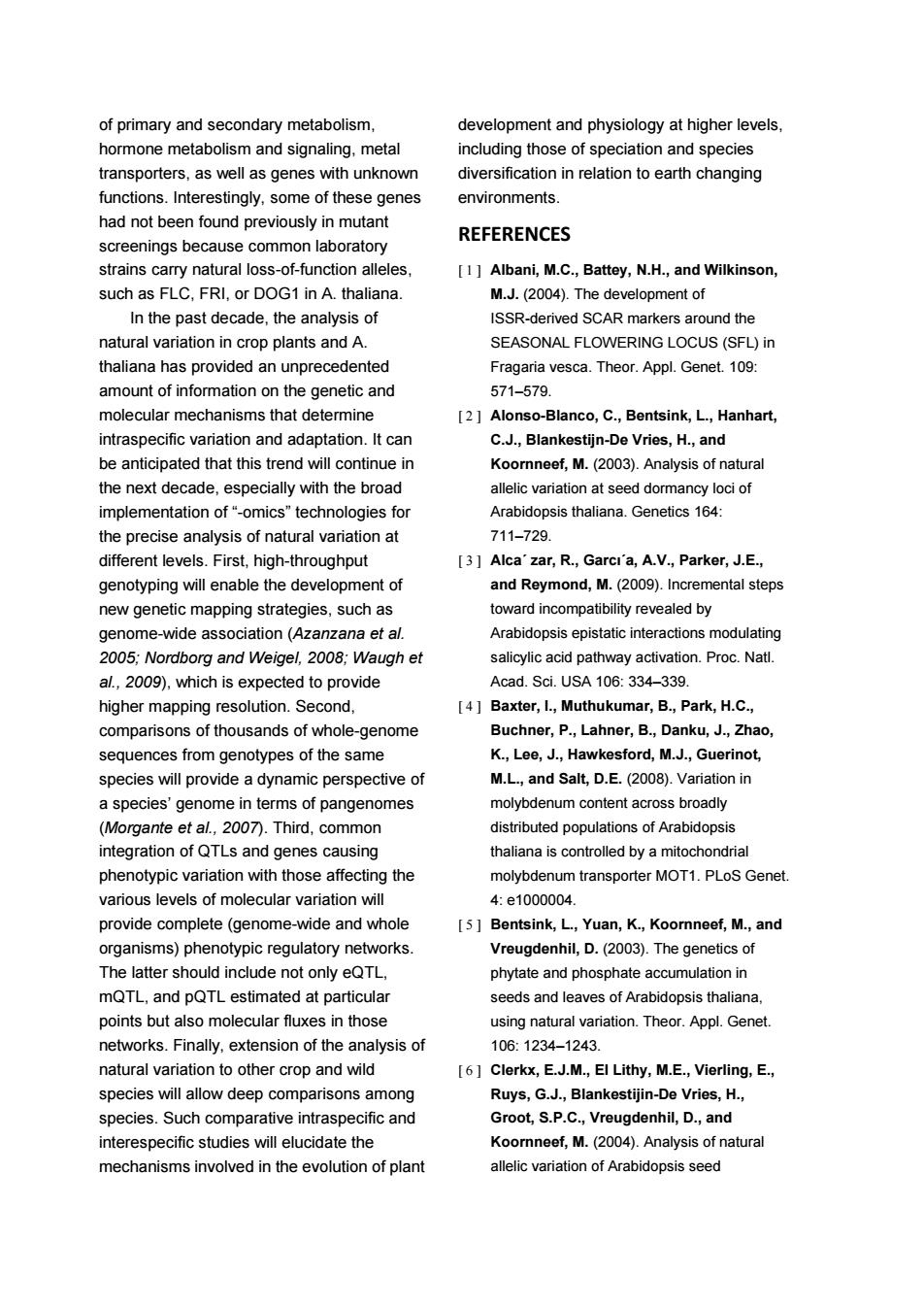正在加载图片...

of primary and secondary metabolism, development and physiology at higher levels, hormone metabolism and signaling,metal including those of speciation and species transporters,as well as genes with unknown diversification in relation to earth changing functions.Interestingly,some of these genes environments. had not been found previously in mutant REFERENCES screenings because common laboratory strains carry natural loss-of-function alleles, [1 Albani,M.C.,Battey,N.H.,and Wilkinson, such as FLC,FRI.or DOG1 in A.thaliana. M.J.(2004).The development of In the past decade,the analysis of ISSR-derived SCAR markers around the natural variation in crop plants and A. SEASONAL FLOWERING LOCUS(SFL)in thaliana has provided an unprecedented Fragaria vesca.Theor.Appl.Genet.109: amount of information on the genetic and 571-579 molecular mechanisms that determine [2 Alonso-Blanco,C.,Bentsink,L.,Hanhart, intraspecific variation and adaptation.It can C.J.,Blankestijn-De Vries,H.,and be anticipated that this trend will continue in Koornneef,M.(2003).Analysis of natural the next decade,especially with the broad allelic variation at seed dormancy loci of implementation of"-omics"technologies for Arabidopsis thaliana.Genetics 164: the precise analysis of natural variation at 711-729. different levels.First,high-throughput [3 Alca'zar,R.,Garci'a,A.V.,Parker,J.E., genotyping will enable the development of and Reymond,M.(2009).Incremental steps new genetic mapping strategies,such as toward incompatibility revealed by genome-wide association(Azanzana et al. Arabidopsis epistatic interactions modulating 2005;Nordborg and Weigel,2008;Waugh et salicylic acid pathway activation.Proc.Natl. al.,2009),which is expected to provide Acad.Sci.USA 106:334-339. higher mapping resolution.Second, [4 Baxter,I.,Muthukumar,B.,Park,H.C., comparisons of thousands of whole-genome Buchner,P.,Lahner,B.,Danku,J.,Zhao, sequences from genotypes of the same K.,Lee,J.,Hawkesford,M.J.,Guerinot, species will provide a dynamic perspective of M.L.,and Salt,D.E.(2008).Variation in a species'genome in terms of pangenomes molybdenum content across broadly (Morgante et al.,2007).Third,common distributed populations of Arabidopsis integration of QTLs and genes causing thaliana is controlled by a mitochondrial phenotypic variation with those affecting the molybdenum transporter MOT1.PLoS Genet. various levels of molecular variation will 4:e1000004. provide complete (genome-wide and whole [5]Bentsink,L.,Yuan,K.,Koornneef,M.,and organisms)phenotypic regulatory networks. Vreugdenhil,D.(2003).The genetics of The latter should include not only eQTL, phytate and phosphate accumulation in mQTL,and pQTL estimated at particular seeds and leaves of Arabidopsis thaliana, points but also molecular fluxes in those using natural variation.Theor.Appl.Genet. networks.Finally,extension of the analysis of 106:1234-1243. natural variation to other crop and wild [6]Clerkx,E.J.M.,EI Lithy,M.E.,Vierling,E., species will allow deep comparisons among Ruys,G.J.,Blankestijin-De Vries,H., species.Such comparative intraspecific and Groot,S.P.C.,Vreugdenhil,D.,and interespecific studies will elucidate the Koornneef,M.(2004).Analysis of natural mechanisms involved in the evolution of plant allelic variation of Arabidopsis seedof primary and secondary metabolism, hormone metabolism and signaling, metal transporters, as well as genes with unknown functions. Interestingly, some of these genes had not been found previously in mutant screenings because common laboratory strains carry natural loss-of-function alleles, such as FLC, FRI, or DOG1 in A. thaliana. In the past decade, the analysis of natural variation in crop plants and A. thaliana has provided an unprecedented amount of information on the genetic and molecular mechanisms that determine intraspecific variation and adaptation. It can be anticipated that this trend will continue in the next decade, especially with the broad implementation of “-omics” technologies for the precise analysis of natural variation at different levels. First, high-throughput genotyping will enable the development of new genetic mapping strategies, such as genome-wide association (Azanzana et al. 2005; Nordborg and Weigel, 2008; Waugh et al., 2009), which is expected to provide higher mapping resolution. Second, comparisons of thousands of whole-genome sequences from genotypes of the same species will provide a dynamic perspective of a species’ genome in terms of pangenomes (Morgante et al., 2007). Third, common integration of QTLs and genes causing phenotypic variation with those affecting the various levels of molecular variation will provide complete (genome-wide and whole organisms) phenotypic regulatory networks. The latter should include not only eQTL, mQTL, and pQTL estimated at particular points but also molecular fluxes in those networks. Finally, extension of the analysis of natural variation to other crop and wild species will allow deep comparisons among species. Such comparative intraspecific and interespecific studies will elucidate the mechanisms involved in the evolution of plant development and physiology at higher levels, including those of speciation and species diversification in relation to earth changing environments. REFERENCES [ 1 ] Albani, M.C., Battey, N.H., and Wilkinson, M.J. (2004). The development of ISSR-derived SCAR markers around the SEASONAL FLOWERING LOCUS (SFL) in Fragaria vesca. Theor. Appl. Genet. 109: 571–579. [ 2 ] Alonso-Blanco, C., Bentsink, L., Hanhart, C.J., Blankestijn-De Vries, H., and Koornneef, M. (2003). Analysis of natural allelic variation at seed dormancy loci of Arabidopsis thaliana. Genetics 164: 711–729. [ 3 ] Alca´ zar, R., Garcı´a, A.V., Parker, J.E., and Reymond, M. (2009). Incremental steps toward incompatibility revealed by Arabidopsis epistatic interactions modulating salicylic acid pathway activation. Proc. Natl. Acad. Sci. USA 106: 334–339. [ 4 ] Baxter, I., Muthukumar, B., Park, H.C., Buchner, P., Lahner, B., Danku, J., Zhao, K., Lee, J., Hawkesford, M.J., Guerinot, M.L., and Salt, D.E. (2008). Variation in molybdenum content across broadly distributed populations of Arabidopsis thaliana is controlled by a mitochondrial molybdenum transporter MOT1. PLoS Genet. 4: e1000004. [ 5 ] Bentsink, L., Yuan, K., Koornneef, M., and Vreugdenhil, D. (2003). The genetics of phytate and phosphate accumulation in seeds and leaves of Arabidopsis thaliana, using natural variation. Theor. Appl. Genet. 106: 1234–1243. [ 6 ] Clerkx, E.J.M., El Lithy, M.E., Vierling, E., Ruys, G.J., Blankestijin-De Vries, H., Groot, S.P.C., Vreugdenhil, D., and Koornneef, M. (2004). Analysis of natural allelic variation of Arabidopsis seed